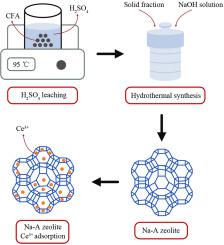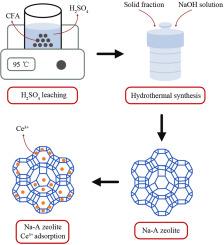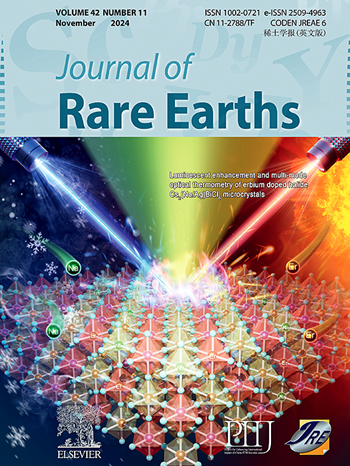从粉煤灰中合成 Na-A 沸石及其在铈(III)吸附中的应用
IF 7.2
1区 化学
Q1 CHEMISTRY, APPLIED
引用次数: 0
摘要
从废物中回收稀土元素(REEs)是环境可持续再利用和废水管理方法的必要条件。以粉煤灰(CFA)为原料合成了 Na-A 沸石,并将其用于吸附 Ce3+。傅立叶变换红外光谱(FTIR)在 790、500 和 467 cm-1 处显示了硅-O-硅、硅与铝-O 和硅-O-的键振动峰。表面积为 15.88 m2/g,孔径为 2.14 nm。扫描电镜图像显示其呈立方体形状,这表明沸石已经形成。场发射和能量色散光谱(EDS)显示形成了 Si、Al、Na 和 O。吸附 Ce3+ 的最佳条件是浓度为 50 ppm、时间为 360 分钟、pH 值为 6。结果表明,Na-A 沸石对 Ce3+ 的吸附是假二阶吸附。使用 HNO3 进行解吸试验比使用 HCl 和 H2SO4 更有效。4 个循环的解吸效率为 97.22%。使用真实废水样本进行的吸附测试表明,吸附效率为 83.35%。本文章由计算机程序翻译,如有差异,请以英文原文为准。


Synthesis and characteristics of Na-A zeolite from coal fly ash and application for adsorption of cerium(III)
Recycling rare earth elements (REEs) from waste is necessary for an environmentally sustainable reuse and wastewater management approach. Na-A zeolite was synthesized from coal fly ash (CFA) and applied for Ce3+ adsorption. Fourier transform infrared (FTIR) spectra show peaks at 790, 500 and 467 cm−1, which are bond vibrations of Si–O–Si, Si with Al–O and Si–O–. The surface area is 15.88 m2/g, with a pore size of 2.14 nm. SEM images show a cubic shape, which indicates the formation of zeolite. Field emission and energy disperse spectroscopy (EDS) shows the formation of Si, Al, Na, and O. Na-A zeolite was applied for Ce3+ adsorption. The optimum conditions for Ce3+ adsorption are 50 ppm concentration, 360 min, and pH 6. The maximum adsorption capacity is 176.49 mg/g. Based on the results, it is found that the adsorption of Ce3+ by Na-A zeolite is pseudo-second-order. The desorption test using HNO3 is more effective than using HCl and H2SO4. A desorption efficiency of 97.22% is obtained at 4 cycles. Adsorption test using real sample wastewater demonstrates an adsorption efficiency of 83.35%.
求助全文
通过发布文献求助,成功后即可免费获取论文全文。
去求助
来源期刊

Journal of Rare Earths
化学-应用化学
CiteScore
8.70
自引率
14.30%
发文量
374
审稿时长
1.7 months
期刊介绍:
The Journal of Rare Earths reports studies on the 17 rare earth elements. It is a unique English-language learned journal that publishes works on various aspects of basic theory and applied science in the field of rare earths (RE). The journal accepts original high-quality original research papers and review articles with inventive content, and complete experimental data. It represents high academic standards and new progress in the RE field. Due to the advantage of abundant RE resources of China, the research on RE develops very actively, and papers on the latest progress in this field emerge every year. It is not only an important resource in which technicians publish and obtain their latest research results on RE, but also an important way of reflecting the updated progress in RE research field.
The Journal of Rare Earths covers all research and application of RE rare earths including spectroscopy, luminescence and phosphors, rare earth catalysis, magnetism and magnetic materials, advanced rare earth materials, RE chemistry & hydrometallurgy, RE metallography & pyrometallurgy, RE new materials, RE solid state physics & solid state chemistry, rare earth applications, RE analysis & test, RE geology & ore dressing, etc.
 求助内容:
求助内容: 应助结果提醒方式:
应助结果提醒方式:


